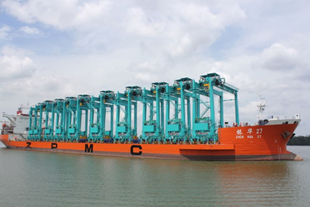Port of Tanjung Pelepas keen to move forward with projects
Container Management

The RTGs on their way to PTP
Overall volume for Q1 2020 at the Port of Tanjung Pelepas (PTP) was “beyond expectations”, largely due to the contribution of transhipment cargo.
However, local cargo which is a fraction of the port’s total volume recorded a decrease as expected due to COVID-19 global pandemic.
From a terminal perspective, PTP will be investing in additional equipment as well as reassessing the current footprint envisaged to increase its terminal handling capacity and capabilities.
This includes the procurement of 10 additional full electrical twin lift rubber-tyred gantry (RTG) cranes which were safely delivered to PTP in May 2020 and the arrival of four new ship-to-shore (STS) super post-Panamax quay cranes in June 2020.
The super post-Panamax cranes, able to handle the biggest vessels in the market, are part of an order by PTP for eight cranes last year to enable the port to create a new full capacity berth to receive these mega vessels.
The remaining four quay cranes are expected to arrive by July 2020.
This acquisition will also complement PTP’s earlier upgrading of its berths and channel dredging, which had deepened the draft to 18.0 m, going to 18.5 m by end of 2020.
Since free zone land is almost at a full take up rate, PTP will also continue to develop and start the next phase of its free zone expansion.
The extension of Pelepas Free Zone, accounts for 100 acres of land that is currently being developed with necessary infrastructure for leasing in 2023.
Prospective investors can lease land parcels for 30 years at competitive rates to build warehouses for short and long-term rentals, or factories for light and environmentally friendly manufacturing activities.
Marco Neelsen, CEO of PTP, said: “We are expanding our free zone land as we foresee the interest and growth in our free zone will remain strong”.
“This will deliver leasable land primarily targeting regional distribution centre (RDC) set-ups to Multinational Corporations (MNC) and global manufacturers.”
With regards to digital processes, PTP has successfully migrated its terminal operating system (TOS) to Navis N4 in 2019, representing one of the largest such terminal system migration projects yet undertaken.
This year, PTP has recently announced the successful go-live of its First Phase intelligent Enterprise Resource Planning system (ERP) to transform and streamline the company’s core back-end operations such as finance, human resources and procurement to keep up with the changing digital landscape.
An asset digitisation project is also scheduled for this year to provide a full digitised view of all terminal equipment. All this is in line with PTP’s aspiration to become an advanced preferred port in the region.
Regarding human capital development, PTP has developed various digitisation platforms to further encourage blue collar workforce performance and productivity that leads to better terminal efficiency.
The port handled 9.1m teu last year, seeing volume growth for transhipment and local cargo, while the PTP Free Zone, which is part of the terminal ecosystem, recorded a 15% jump in volumes.
Over the years, PTP has benefited from its location in the middle of the East-West trade lanes, while forming partnerships with the 2M Alliance and the Ocean Alliance.
“The partnerships have boosted PTP’s business growth and strengthened existing relationships with shipping companies as well as secured future cargo volume,” said Neelsen.
Utilising this strategy, the port provides support as either a primary or a secondary hub thus reducing carriers’ reliance on a sole main hub, and forming a key node in the alliances’ global networks.